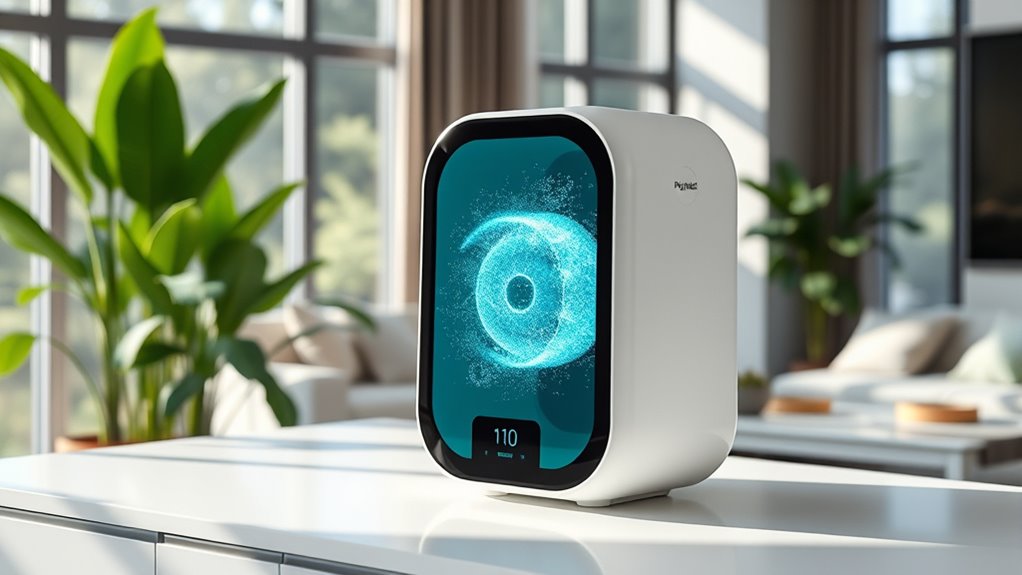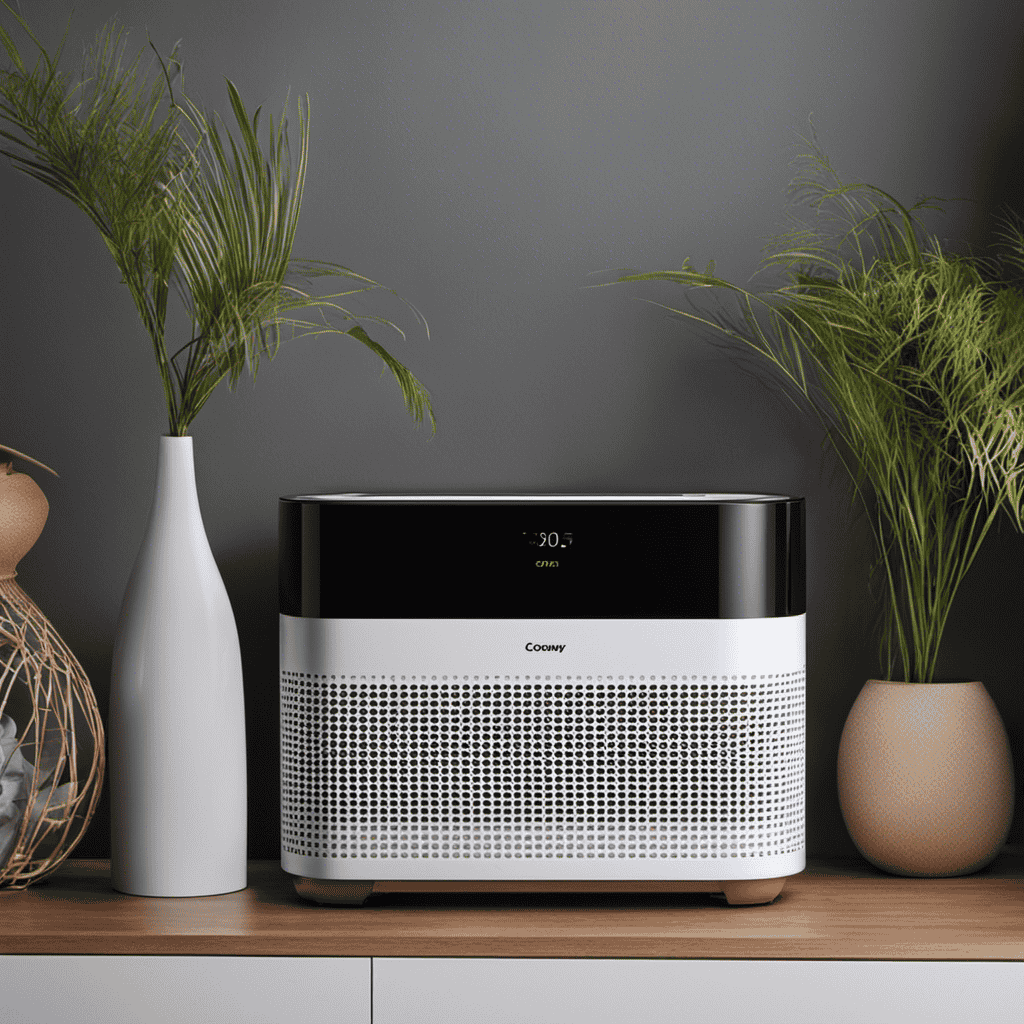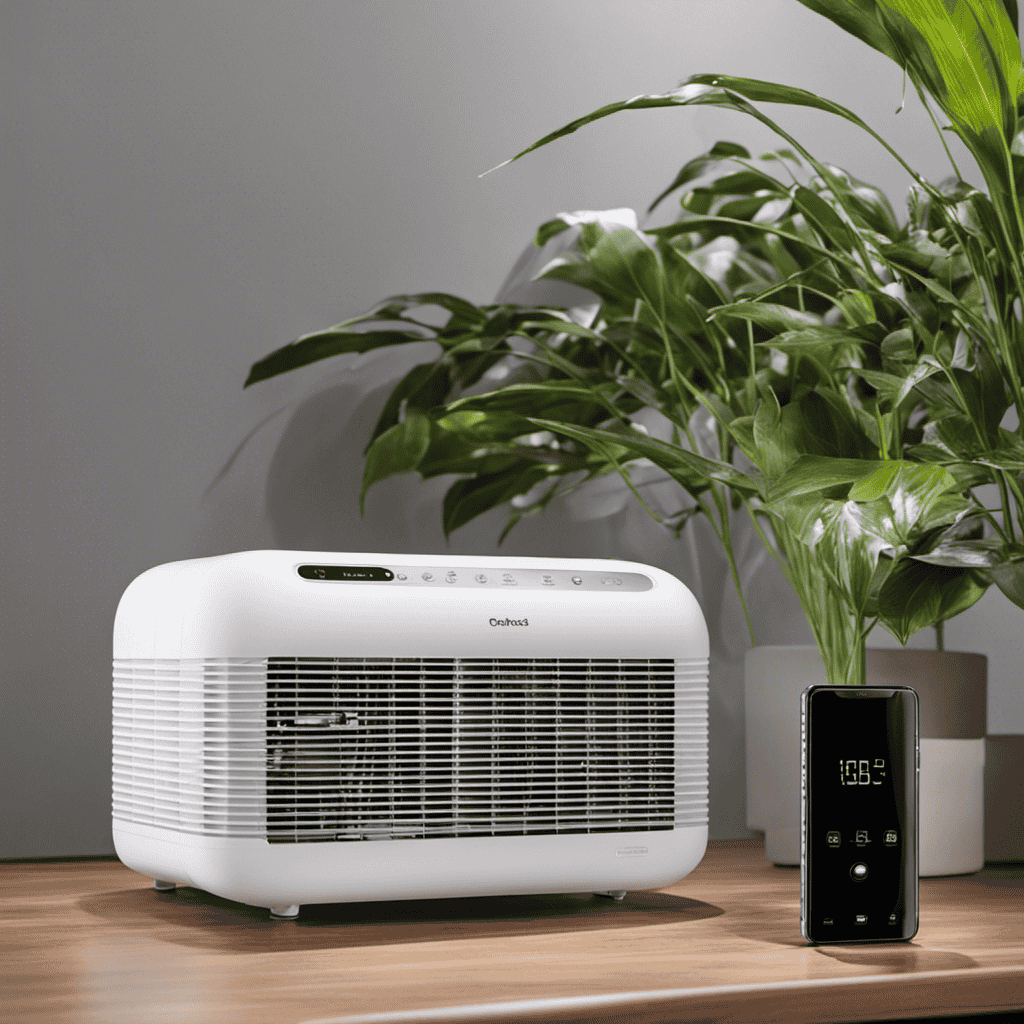Emerging air purifier technologies are revolutionizing how you breathe cleaner air. Advanced filters like HEPA and activated charcoal now combine with photocatalytic oxidation to efficiently remove particles, odors, and harmful gases. Smart devices connected via IoT offer real-time monitoring and effortless control, while eco-friendly designs minimize environmental impact. Portable and personal units keep you protected on the go. To discover how these innovations can improve your indoor environment, explore the latest trends shaping the future of clean air.
Key Takeaways
- Advanced filtration combining HEPA and activated charcoal offers comprehensive removal of particles and gases for cleaner indoor air.
- Photocatalytic oxidation with improved catalysts efficiently breaks down VOCs, bacteria, and odors into harmless substances.
- IoT-enabled air purifiers provide real-time monitoring, remote control, and smart automation for optimal air quality management.
- Eco-friendly, biodegradable filters made from natural materials reduce environmental impact and support sustainability efforts.
- Portable, wearable air quality devices with smart sensors enable on-the-go pollution detection and personalized air purification.
Advanced Filtration Systems and Their Benefits
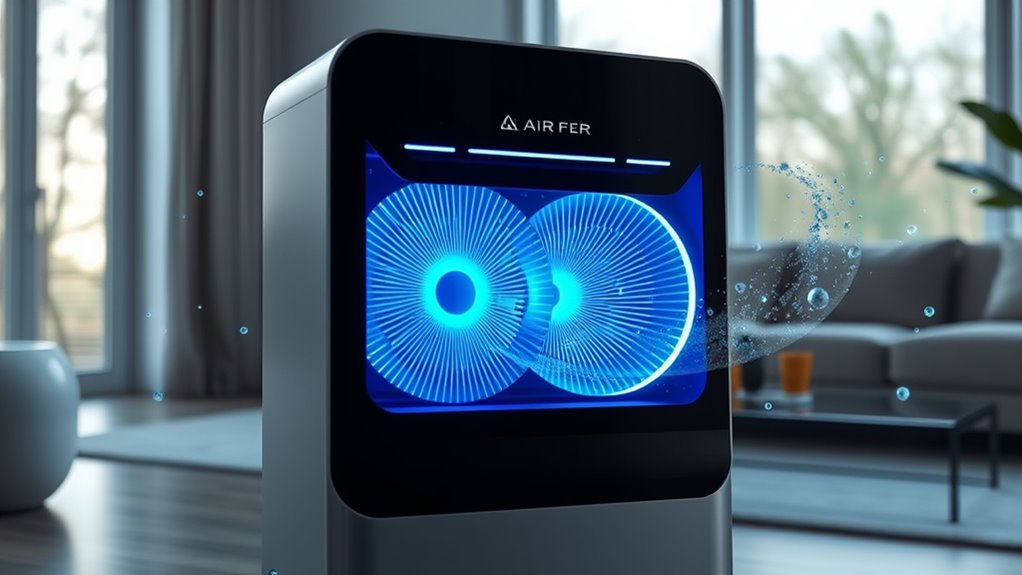
Have you ever wondered how some air purifiers manage to remove even the tiniest pollutants from the air? It’s thanks to advanced filtration systems like HEPA filters and activated charcoal. HEPA filters trap particles as small as 0.3 microns, including dust, pollen, pet dander, and smoke. They’re highly effective at capturing airborne allergens, improving indoor air quality considerably. Activated charcoal, on the other hand, absorbs odors, volatile organic compounds (VOCs), and harmful gases, making the air fresher and safer to breathe. Combining these filters creates an all-encompassing approach to air purification, tackling both particulate matter and gaseous pollutants. Additionally, the integration of Cultural innovations and research in filter technology continues to enhance the effectiveness of these systems. These advanced systems ensure your environment is cleaner, healthier, and more comfortable, especially for allergy sufferers or those with respiratory issues. Moreover, ongoing technological advancements are leading to the development of filters with longer lifespans and improved environmental sustainability. For example, innovations in filter materials are leading to longer-lasting and more environmentally friendly options, inspired by the latest breakthroughs in AI Smasher machine learning algorithms that optimize filter design and maintenance schedules.
Photocatalytic Oxidation and Its Role in Air Purification
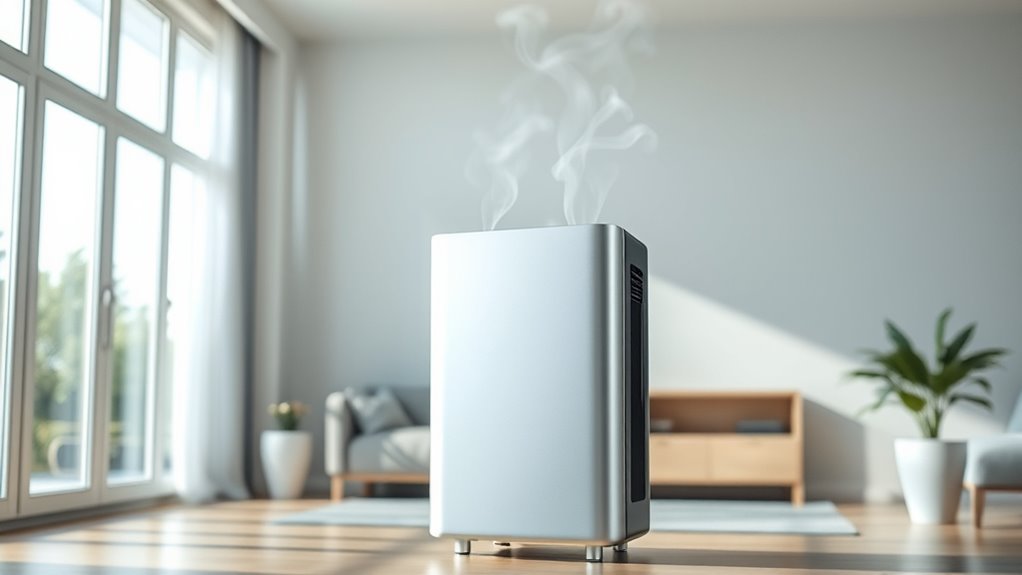
Photocatalytic oxidation (PCO) is an innovative air purification technology that uses light-activated catalysts to eliminate pollutants. Its high photocatalytic efficiency enables it to break down volatile organic compounds (VOCs), bacteria, and odors effectively. When exposed to UV or visible light, the catalyst generates reactive radicals that oxidize contaminants into harmless substances like carbon dioxide and water. One of PCO’s strengths is catalyst regeneration, which allows the catalyst surface to remain active over time without needing frequent replacement. This ongoing regeneration ensures sustained purification performance and reduces maintenance costs. Moreover, integrating AI in Business with PCO technology can enhance monitoring and control systems for optimal air quality management. PCO systems are especially useful in environments requiring continuous air cleaning, making them a promising addition to the future of clean air technology. Additionally, the development of catalyst materials continues to improve the overall efficiency and durability of PCO systems, further supporting their widespread adoption. The ongoing research into advanced coatings aims to extend the lifespan and effectiveness of catalysts in various settings. Furthermore, recent advancements in nanotechnology are contributing to more efficient and robust catalyst development for these systems.
Smart Air Purifiers With Iot Integration
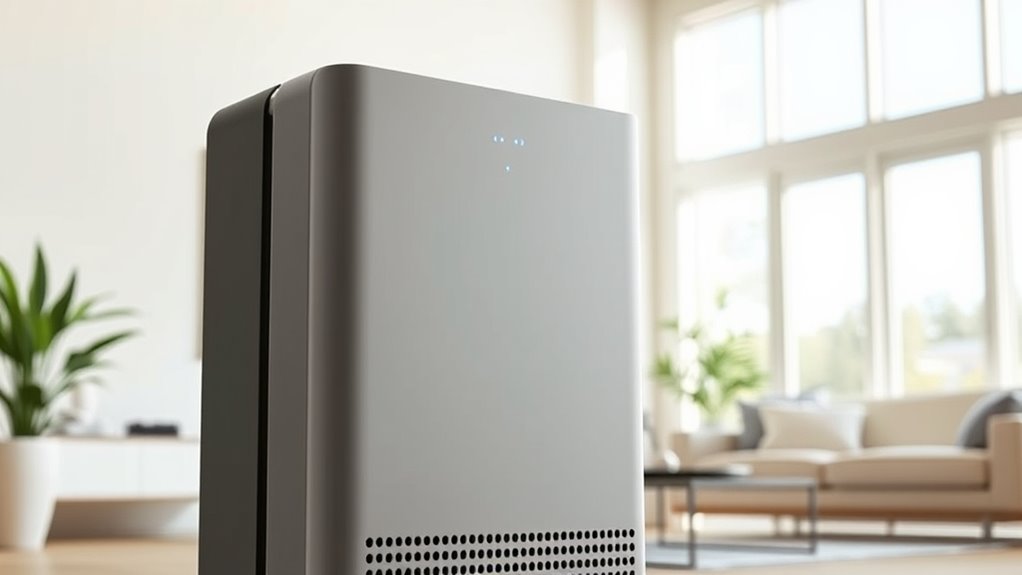
Smart air purifiers with IoT integration are transforming how you monitor and manage indoor air quality. With voice control, you can easily adjust settings or check status without lifting a finger. These devices connect to your home’s Wi-Fi, enabling real-time monitoring of air quality levels through smartphone apps or smart home systems. You’ll receive instant updates on pollutants, allergens, and humidity, allowing you to respond quickly. IoT-enabled purifiers learn your preferences over time, optimizing performance automatically. This seamless integration ensures cleaner air with minimal effort, giving you peace of mind. Whether you’re home or away, you can control and monitor your air purifier remotely. These features make smart air purifiers essential for maintaining a healthier indoor environment effortlessly. Reliable indoor air quality monitoring helps ensure your environment remains safe and healthy at all times.
Biodegradable and Eco-Friendly Purification Technologies
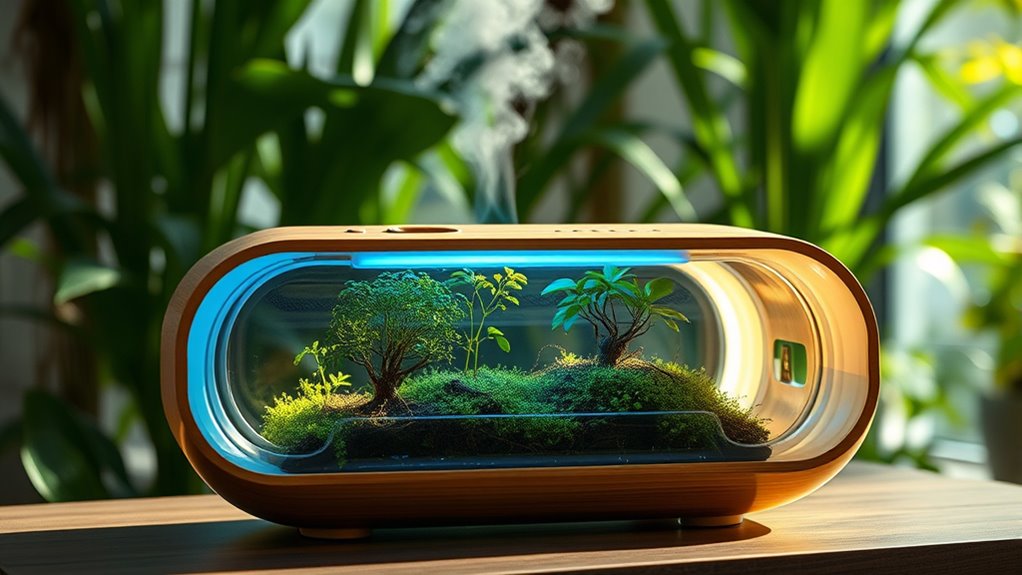
As concerns about environmental impact grow, biodegradable and eco-friendly purification technologies are gaining prominence in air quality management. You’ll find biodegradable filters made from natural fibers or plant-based materials that break down safely after use, reducing landfill waste. These filters often utilize eco friendly materials like bamboo, hemp, or recycled fabrics, making them sustainable choices. By choosing air purifiers with biodegradable filters, you help minimize pollution caused by synthetic plastics and non-degradable components. These environmentally conscious options also often incorporate sustainable materials that promote a healthier indoor environment. Incorporating biodegradable filters not only reduces waste but also supports environmental sustainability efforts in the industry. Eco-friendly materials not only reduce environmental harm but also promote healthier indoor air quality. As this technology advances, it offers a greener alternative to traditional filters, aligning air purification with sustainability goals. Integrating biodegradable filter options can enhance the overall eco-friendliness of your air purification system. Additionally, the integration of automation technology in air purifiers can optimize their performance and energy efficiency, leading to smarter and more eco-conscious operation. Embracing biodegradable and eco-friendly options helps you contribute to a cleaner planet while maintaining effective air quality.
Emerging Trends in Portable and Personal Air Quality Devices
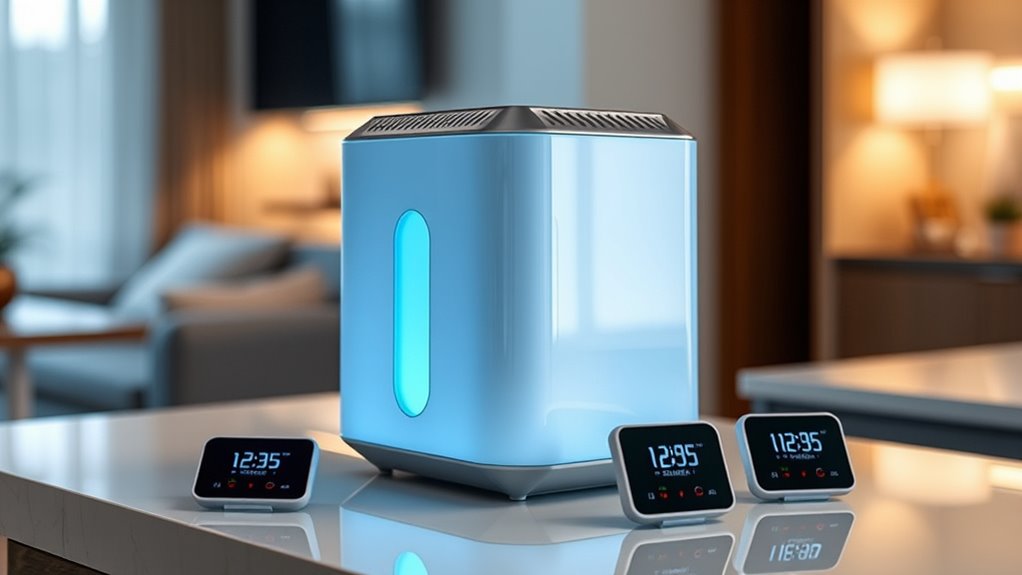
Have you noticed how portable and personal air quality devices are transforming the way we approach clean air? These emerging trends make it easier for you to monitor and improve air quality on the go. Wearable air monitors provide real-time data, allowing you to track pollutants wherever you are. Portable ionizers, compact and efficient, remove airborne particles without bulky equipment. These devices are becoming smarter, often syncing with smartphones for easy control and data sharing. Additionally, advances in indoor air quality technology help maintain healthier environments inside your home or workspace. Incorporating personal health monitoring features can further empower users to take proactive steps in managing their air quality. Innovations like smart sensors are enabling more precise detection of airborne contaminants, enhancing personal air management solutions. As technology continues to evolve, the integration of air purifier features into everyday devices is expected to further improve our ability to breathe clean air effortlessly. Moreover, the development of HEPA filter technology in portable devices ensures that even the smallest particles are effectively captured, improving overall air purity.
Frequently Asked Questions
How Do Emerging Air Purifier Technologies Impact Indoor Allergy Management?
Emerging air purifier technologies substantially improve indoor allergy management by using smart sensors to detect allergen levels in real-time, allowing for automatic adjustments. Enhanced HEPA filters now better trap pollen, pet dander, and dust mites, reducing allergy symptoms. You’ll notice cleaner air and fewer allergy triggers, helping you breathe easier. These innovations make maintaining a healthy indoor environment more effortless and effective, especially for allergy sufferers like you.
What Are the Potential Health Risks of New Air Purification Methods?
You might wonder about the health risks of new air purification methods. While these devices can improve air quality, they can also pose risks like chemical exposure from certain filters or materials. It’s vital to take into account device safety, ensuring products are certified and free from harmful emissions. Staying informed helps you reduce potential health hazards and enjoy cleaner, safer indoor air with emerging technologies.
How Affordable Are the Latest Air Purification Innovations for Consumers?
You’ll find that the latest air purification innovations are increasingly affordable, thanks to evolving cost comparison and affordability trends. While some advanced models may still carry a higher price tag, many new devices are designed to be budget-friendly without sacrificing performance. As technology advances, expect prices to drop further, making clean air solutions more accessible for everyone. You can enjoy healthier indoor air without breaking the bank.
Can These Technologies Effectively Eliminate Airborne Viruses and Bacteria?
You might wonder if new air purifier tech can truly eliminate airborne viruses and bacteria. Many devices now combine HEPA filtration, which captures tiny particles, with UV sterilization, which kills germs on contact. These technologies work together to markedly reduce airborne pathogens, making your environment safer. While no system is perfect, advancements are improving effectiveness, giving you better protection against viruses and bacteria in your indoor air.
What Are the Long-Term Environmental Effects of Advanced Purification Systems?
Like a double-edged sword, advanced purification systems bring both promise and caution. You might find that eco-friendly materials reduce environmental harm, but increased energy consumption could offset these benefits. Long-term effects depend on how sustainably manufacturers design these units. If you prioritize energy-efficient models and recyclable parts, you can help make certain these systems support healthier indoor air without harming the planet.
Conclusion
As you explore these emerging air purifier technologies, you’re stepping into a gust of fresh air that transforms your space into a sanctuary. These innovations, like a gentle breeze clearing away pollutants, promise a future where clean air is more accessible and eco-friendly. Embrace these advancements, and you’ll not only protect your health but also contribute to a greener planet. The future of air purification is bright, ready to refresh your world with every inhalation you take.
